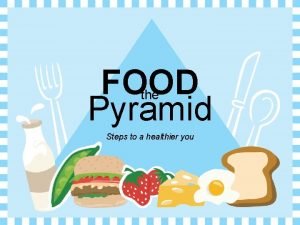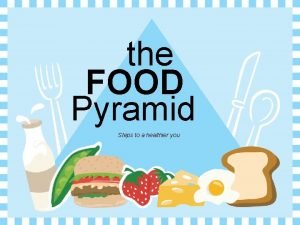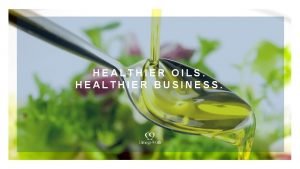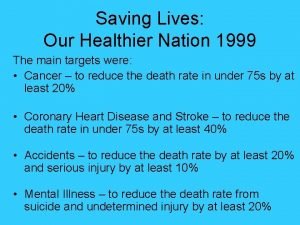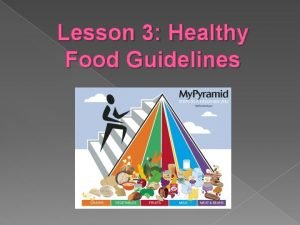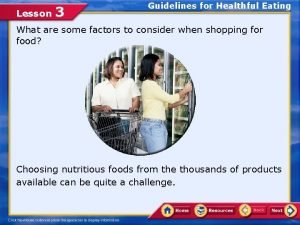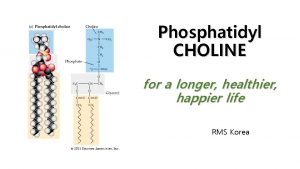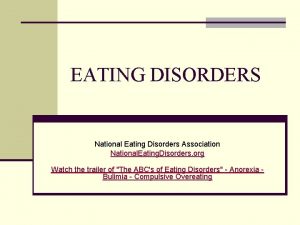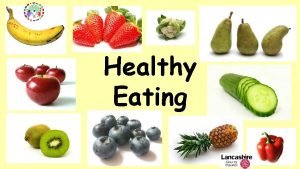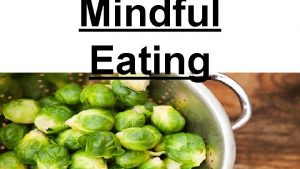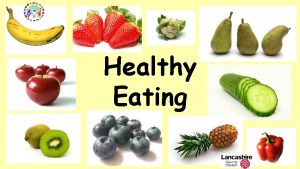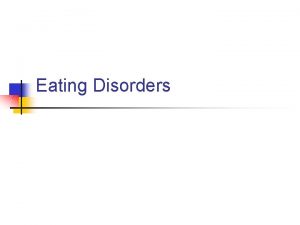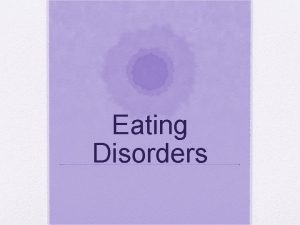ORGANIC EATING A GUIDE TO A HAPPIER HEALTHIER














- Slides: 14

ORGANIC EATING A GUIDE TO A HAPPIER HEALTHIER YOU! Sponsored by The National Organic Program

WHAT IS ORGANIC? The word organic is a labeling term for food and other agricultural products that have been grown and produced by the standards set forth by the USDA organic regulations (Baier, 2012).

The standards that are required by USDA is the integration of cultural, biological, and mechanical practices that encourage the cycling of resources, promotes ecological balance, and conserve biodiversity. What all of this means is that organic operations must maintain or enhance soil and water quality while also conserving wetlands, woodlands, and wildlife. Synthetic fertilizers, sewage sludge, irradiation, and genetic engineering is prohibited and may not be used (Baier & Ahramjian 2012).

Good nutrition is essential for good health. And because people don’t eat right, common sense says that everybody should take a good multivitamin daily as a foundation of health and nutrition. In a 2002 article in the Journal of the American Medical Association, “Vitamins for Chronic Disease Prevention in Adults, ” has stated that , “inadequate intake of several vitamins has been linked to chronic diseases, including coronary heart disease, cancer, and osteoporosis (Fawcett, 2015). ”

WHAT IS ORGANIC CERTIFICATION? By having the organic certification, it verifies that your farm or handling facility, no matter where its located in the world complies with the U. S. Department of Agriculture (USDA) organic regulations and allows you to sell, label, and represent your products as being organic. The USDA National Organic Program (NOP) administers these regulations, with substantial input from its citizen advisory board and the public (baier & Ahramjian, 2012).

WHAT PRODUCTS ARE ELIGIBLE FOR ORGANIC CERTIFICATION? USDA standards recognize four categories of organic production: • Crops. Plants that are grown to be harvested as food, livestock feed, or fiber used to add nutrients to the field(baier & Ahramjian, 2012). • Livestock. Animals that can be used for food or in the production of food, fiber, or feed (baier & Ahramjian, 2012).

Processed/multi-ingredient products. Items that have been handled and packaged (e. g. , chopped carrots) or combined, processed, and packaged (e. g. , bread or soup) (baier & Ahramjian, 2012). Wild crops. Plants from a growing site that is not cultivated(baier & Ahramjian, 2012).

Consumers are confronted with three choices in vitamins: natural, synthetic, and organic(Fawcett, 2015). Synthetic vitamins: Scientists developed synthetic vitamins that are inexpensive to manufacture. They are identical in their atomic structure when compared to vitamins derived from plant sources and can only be distinguished in only in a laboratory setting (Fawcett, 2015).

Natural vitamins: Sometimes are difficult to determine the difference between “synthetic” and “natural” vitamins. But, some define a natural vitamin as a concentrated nutrient derived from a quality natural source. It should have a maximum retention of the natural material and no artificial colors, sweeteners, or preservatives added (Fawcett, 2015. Organic vitamins. Consumers can find two types of supplements labeled “organic” on the market: Those that adhere to the grocery store definition of organic, nutrients that are derived from whole foods grown without insecticides, pesticides, and herbicides and manufactured from ingredients that are certified organic) and supplements adhering to the scientific definition of organic (Fawcett, 2015).

Here’s a simple list of questions to ask to make sure that you are actually getting a supplement that is what it claims to be: 1. Does the product contain any binders, fillers, or excipients? (If so, they are likely synthetic. ) 2. Does the product contain preservatives? 3. Is this product heat-processed? 4. Are minerals present? (Minerals may catalyze the vitamins. ) 5. Does the product contain ascorbic acid? 6. Does the product contain vitamin E, called dl-alpha-tocopherol. 7. Is the product artificially flavored?

UNDERSTANDING THE LABEL • PLU codes are four digit numbers that identify different types of produce. For example, #4011 is the code for a standard yellow banana (Kahn, 2012). • The number 9 prefix added to a PLU signifies that an item is organic. For example, #94011 is the code for an organic yellow banana (Kahn, 2012).

• A number 8 prefix added to a PLU signifies that an item is genetically engineered (GE). For example, #84011 is the code for a genetically engineered yellow banana (Kahn, 2012). • PLU codes and their organic prefixes are in wide use but GE codes are rare at best (Kahn, 2012).

GET TO KNOW THE DIRTY DOZEN AND THE CLEAN 15 Eating fresh produce is the best way to get the nutrients that will help support optimum health. Unfortunately, the pesticides that are used on many crops remain a major health concern. By choosing organic foods, you can reap the health benefits of fruits and vegetables without exposing yourself and your family to potentially harmful chemicals. Pesticides can present real health risks, particularly to children and those with health concerns. The toxicity most commonly associated with pesticides in animal studies include disruptions in the normal functioning of the nervous and endocrine system, and increased risks of cancer (Weil, 2015).

REFERENCE Ahramjian, Lisa & Baier H. Ann. (2012). Organic Certification of Farms and Businesses Producing Agricultural Products. Retrieved November 24, 2014, from http: //www. ams. usda. gov Google Images. (n. d. ) Retrieved November 24, 2014, from http: //www. google. com Kahn, Mike. (2012). Food Labeling: How to Identify Conventional, Organic and GMO Produce. Retrieved November 24, 2014, from http: //blogs. kqed. org Fawcett, J. (n. d. ). Supplements: Synthetic, natural, or organic? Retrieved August 4, 2015 from, http: //www. chiroeco. com/article/2006/Issue 10/PR 3. php Weil, A. (n. d. ). The Dirty Dozen Plus. Retrieved August 4, 2015, from http: //www. drweil. com
 Mypyramid steps to a healthier you
Mypyramid steps to a healthier you Healthier lancashire and south cumbria
Healthier lancashire and south cumbria Mypyramid steps to a healthier you
Mypyramid steps to a healthier you Healthier business group
Healthier business group Building healthier lives
Building healthier lives Our healthier nation (1999)
Our healthier nation (1999) Tall er
Tall er We are we are we are more together
We are we are we are more together The more we get together the happier we'll be
The more we get together the happier we'll be Happy最高級
Happy最高級 Alliteration examples in macbeth
Alliteration examples in macbeth Interactive guide to healthy eating and active living
Interactive guide to healthy eating and active living Brianna k eating disorder
Brianna k eating disorder Your face is killing me figurative language
Your face is killing me figurative language Lesson 3 guidelines for eating
Lesson 3 guidelines for eating
